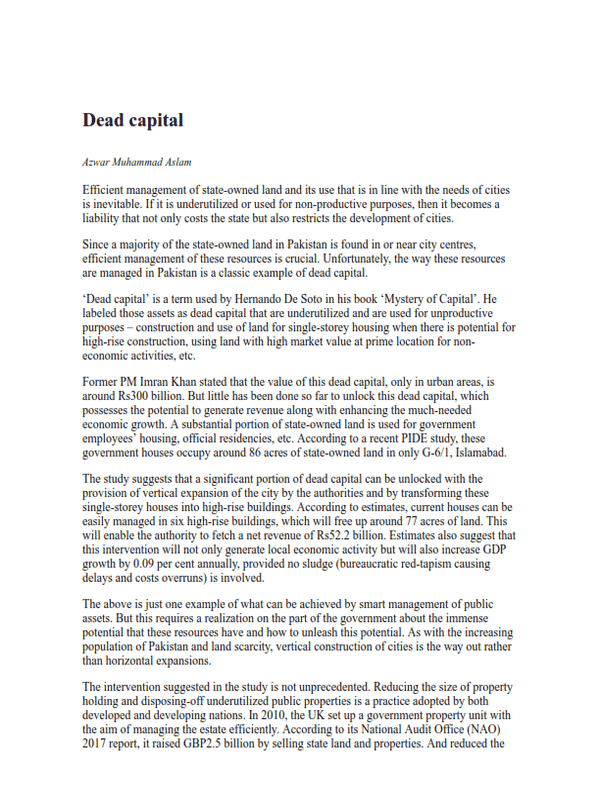
Pakistan Institute of Development Economics
- Home
Our Portals
MenuMenuMenuMenuMenuMenuMenu - ResearchMenuMenuMenuMenuMenuMenuMenu
- Discourse
- The PDR
- Our Researchers
- Academics
- Degree Verification
- Thesis Portal
- Our Portals
Dead Capital
Efficient management of state-owned land and its use that is in line with the needs of cities is inevitable. If it is underutilized or used for non-productive purposes, then it becomes a liability that not only costs the state but also restricts the development of cities.
Since a majority of the state-owned land in Pakistan is found in or near city centres, efficient management of these resources is crucial. Unfortunately, the way these resources are managed in Pakistan is a classic example of dead capital.
‘Dead capital’ is a term used by Hernando De Soto in his book ‘Mystery of Capital’. He labeled those assets as dead capital that are underutilized and are used for unproductive purposes – construction and use of land for single-storey housing when there is potential for high-rise construction, using land with high market value at prime location for non-economic activities, etc.
Former PM Imran Khan stated that the value of this dead capital, only in urban areas, is around Rs300 billion. But little has been done so far to unlock this dead capital, which possesses the potential to generate revenue along with enhancing the much-needed economic growth. A substantial portion of state-owned land is used for government employees’ housing, official residencies, etc. According to a recent PIDE study, these government houses occupy around 86 acres of state-owned land in only G-6/1, Islamabad.
The study suggests that a significant portion of dead capital can be unlocked with the provision of vertical expansion of the city by the authorities and by transforming these single-storey houses into high-rise buildings. According to estimates, current houses can be easily managed in six high-rise buildings, which will free up around 77 acres of land. This will enable the authority to fetch a net revenue of Rs52.2 billion. Estimates also suggest that this intervention will not only generate local economic activity but will also increase GDP growth by 0.09 per cent annually, provided no sludge (bureaucratic red-tapism causing delays and costs overruns) is involved.
The above is just one example of what can be achieved by smart management of public assets. But this requires a realization on the part of the government about the immense potential that these resources have and how to unleash this potential. As with the increasing population of Pakistan and land scarcity, vertical construction of cities is the way out rather than horizontal expansions.
The intervention suggested in the study is not unprecedented. Reducing the size of property holding and disposing-off underutilized public properties is a practice adopted by both developed and developing nations. In 2010, the UK set up a government property unit with the aim of managing the estate efficiently. According to its National Audit Office (NAO) 2017 report, it raised GBP2.5 billion by selling state land and properties. And reduced the state’s annual spending on these estates by GBP775 million. India recently announced a plan to sell state assets worth $81 billion within the period of the next four years.
Pakistan also needs to take initiatives to manage state-owned real estate efficiently to ensure full utilization of these resources. The government can start by forming a database with a centralized record of the land held by the state and its entities, telling the proportion of land held. A part of the problem is also associated with the valuation of land held by the state, which currently ignores the market value and opportunity cost.
The land’s current use and value should be assessed by a team of professional asset management experts instead of civil servants, after which the land must be used with an aim to achieve maximum utilization and as per the needs of the area. The excess underutilized land held by the state better be disposed-of to the private sector for high-rise development.
The writer is a research associate at PIDE, Islamabad. He tweets @__azwar and can be reached at: [email protected]



